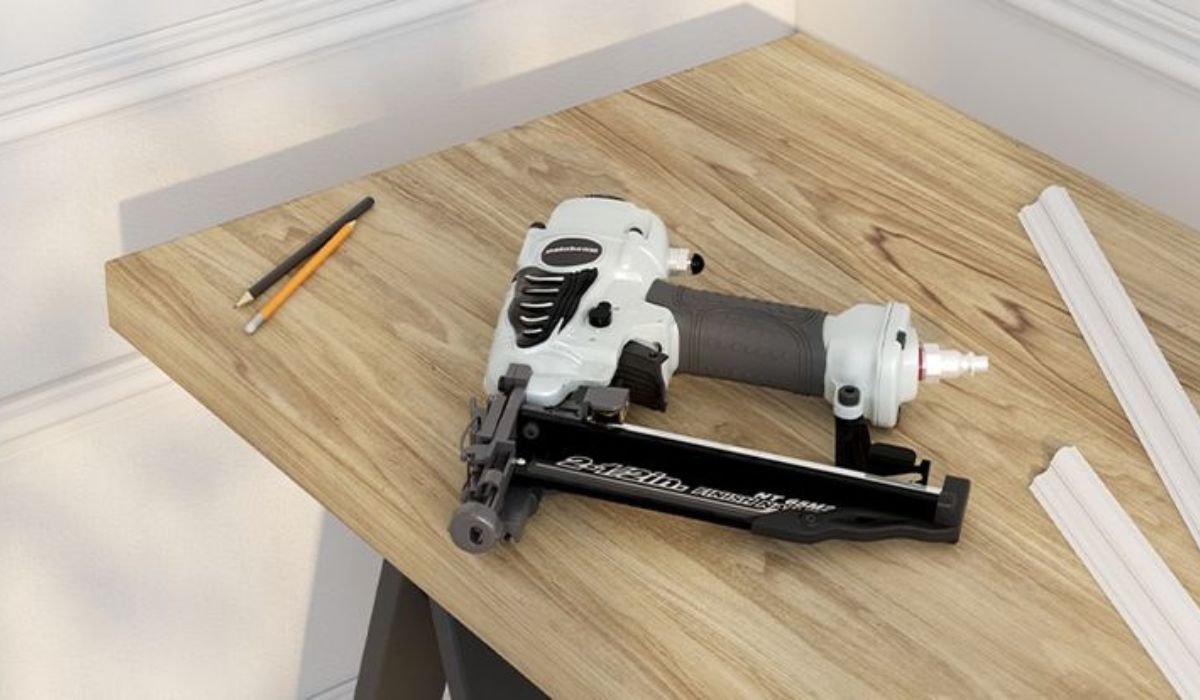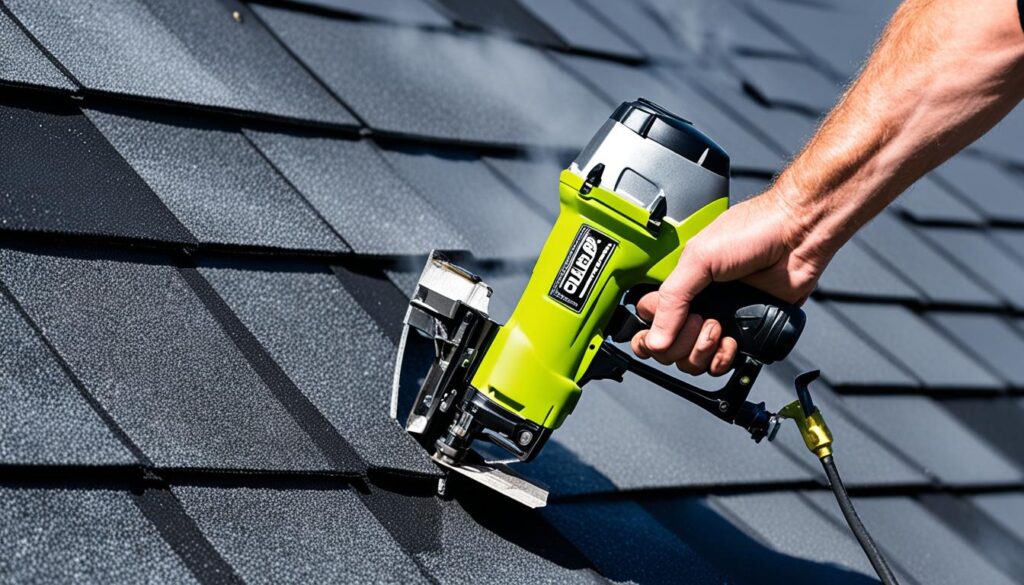
Are you a pro roofer or a lover of DIY projects? If you’re working with asphalt shingles, choosing a good roofing nail gun is key. It boosts how fast, well, and safe your work is. But, there’s so many out there, how to know which is best for you?
Roofing nail guns are special, unlike ones for framing.1 They shoot at a shallower angle and use coiled nails. This means less time reloading, making your work safer on steep roofs. In the U.S. alone, there are around thirty brands of these nailers.1 They vary in power types, features, and prices, adding to the challenge of selecting. But don’t worry – we’ve looked into it to guide you well.
Key Takeaways
- Roofing nail guns are made just for putting up roofing, like asphalt shingles.
- Most people use pneumatic nail guns, with solenoid-powered ones next.1
- They work on different power sources: pneumatic, cordless, and gas.
- Roofing nail guns use coiled nails, which means you reload them less, a big plus on slanted roofs.
- Picking the right nail size and style is very important for keeping your asphalt shingles in place right.
Introduction to Roofing Nail Guns
About 2,000 years ago, the idea of using air pressure for work started. Hero of Alexandria, a Greek thinker, is known for inventing the first steam-powered tool. Later on, a German introduced the vacuum pump, leading to tools powered by air. The first versions of what we call roofing nail guns today showed up in the 1940s. It was during work on the massive “Spruce Goose” airplane project in 1947. A civil engineer made the nail gun to help build the plane’s wooden skin. It was nicknamed The “Flying Lumberyard!”
The Evolution of Roofing Nail Guns
Roofing experts have moved from using only hammers to using nail guns.2 Using the right nails in the correct way is key to a roof’s success. If nails are not right, water could get in or the shingles might move. Roofing hammers have special parts like magnets, shingle gauges, and claws for work with shingles.2 Today, roofing hammers also have places to hold nails, tools to make it less tiring to use the hammer, ways to take off shingles, and even measure shingles in different ways. People who love old tools like to find and keep old roofing hammers.2
Benefits of Using a Roofing Nail Gun
People used hammers in roofing before, doing tasks like cutting and positioning shingles, and nailing precisely.2 Hammers are appreciated for giving users direct feedback, placing nails right, controlling shingle position, being easy to care for, and helping show off high-quality work.2 But hammers are slower than nail guns and take longer for new roofers to learn. Plus, they come in different weights that can affect how well a person works with them.2
Types of Roofing Nail Guns
Pneumatic Roofing Nail Guns
Pneumatic nail guns work with compressed air. They are very common among roofers.1 Some nail guns use solenoids, powered by electromagnetic fields. Others need to be plugged into 120-volt outlets which aren’t ideal for working on roofs.
Cordless Roofing Nail Guns
Dewalt’s 20-volt 15° nail gun is a good example of a cordless option for roof work.1 It doesn’t need a cord or a compressor, and runs on a rechargeable battery.
Gas-Powered Roofing Nail Guns
Some nail guns don’t need electricity or air. They use gunpowder to drive pins into hard materials. Others, known as combustion-powered, rely on gas cartridges for operation.
Roofing Nail Gun Considerations
Nail Length and Gauge
Roofing nail guns vary in angle from 15° to 30°. This angle shows the slope of the nail feeder or how nails are placed in the gun.3 They use either collated or coil nails. Collated nails come in strips for pneumatic nailers, while coil roof nailers have a drum like an old machine gun. Nailer details will also show the sizes of nails it can use, like “1-¾”.
Nail Capacity and Reload Mechanism
4 Roofing contractors favor pneumatic nail guns 85% of the time over hand nailing due to efficiency. The roofing nail gun’s nail capacity and reload system are vital. For example, coil nailers store many nails in a drum, needing less reloading.
Weight and Ergonomics
3 Pneumatic nail guns are often cheaper than cordless ones. But, the tool’s weight and design affect how easy and comfortable it is to use. The nail gun’s total weight, balance, grip, and trigger matter a lot during long roofing jobs.
Roofing nail gun for asphalt shingles
Coil Roofing Nailers for Asphalt Shingles
Roofers prefer using coil roofing nailers for asphalt shingles. These nail guns meet the unique needs of shingle work. 
The NV45AB2 model can use nails from 7/8″ to 1-3/4″ long. So, it’s perfect for various roofing jobs.5 Plus, it’s light at just 5.5 lbs, which means you can work efficiently.5 With the ability to shoot up to 3 nails a second, you’ll finish tasks much faster.5
The NV45AB2 has been the Pro Preferred Nailer by Builder & Developer Magazine for nine years. This award shows its quality and performance.5 It can hold 120 nails, so you don’t have to stop often to reload, making work smoother.5
Choosing the Right Nail Size for Asphalt Shingles
Choosing the right nail size is key for installing asphalt shingles. The Coil Roofing Nailer can use nails from 7/8″ to 1-3/4″ long.5 This variety suits different roofing materials. It ensures you can pick the best nail for your job.
The Coil Roofing Nailer gives you two ways to trigger the nails: Contact or Sequential. Sequential is handy for some jobs.5 And, its tool-less depth setting makes it easy to set up. This means you can nail precisely and get a smooth finish.5
Top Roofing Nail Gun Brands
When talking about roofing nail guns, three big names always come up on top. These are Stanley Bostitch, Dewalt, and Makita. They make top-notch power tools and gear. Roofers and home project lovers trust them for their smart designs and solid performance. Plus, they all back up their products with strong warranties.
Bostitch Roofing Nail Guns
Stanley Bostitch leads the pack when it comes to all sorts of power tools, from staplers to nailers.1 Their roofing nail guns, such as the RN46-1, are perfect for many jobs. For example, they work well with composition roofing and installing insulation or vinyl siding.6 They feel so confident about their nailers that they offer a nice 7-year warranty.7
Dewalt Roofing Nail Guns
Dewalt is well-known in the tool world and offers a bunch of roofing nail guns. These tools are great for pros and weekend handymen.1 Their pneumatic roofing nailers get rave reviews, earning a 4.5-star score from 162 reviewers.6 Dewalt stands behind their products with warranties from 3 years up to a lifetime, depending on what you get.7
Makita Roofing Nail Guns
Makita is a name trusted by many for high-quality tools, and their roofing nail guns are no different.1 Their Metabo HPT models are covered by a 5-year warranty, showing they’re in it for the long haul.7 They’re known for being precise, durable, and user-friendly, making them a go-to for many pros.
Safety Considerations for Roofing Nail Guns
Roofing nail guns are very useful for pros and DIY fans, but they can be dangerous.3 In Canada, nearly 30% of workers have been hurt by a nail gun. So, it’s important to be careful and follow safety rules.3 Most injuries are to the hands and fingers, hurting tendons, joints, nerves, and bones.3
Proper Nail Gun Handling and Operation
It’s crucial to handle and use roofing nail guns correctly to stay safe.3 Those who use sequential triggers have less chance of getting hurt without working slower. But3 if you use a multi-shot trigger, you might hurt yourself more than with a full sequential trigger.3 Multi-shot triggers can be 10% faster for those making wooden structures. But a worker’s skill matters more for how fast and safe they work.3 As new nail gun designs come out, more workers are using them. This makes ongoing safety training really important.3
Personal Protective Equipment (PPE)
Using the right protective gear is key when working with roofing nail guns.8 Over half of nail gun injuries are to the hands and fingers. So, wearing tough gloves and eye protection is a must to lower accident risks.8 OSHA gives specific safety advice for nail guns, which covers trigger types and site procedures. Following these guidelines is essential for staying safe at work.3
Maintenance and Care for Roofing Nail Guns
To keep a roofing nail gun working well for a long time, taking good care of it is key. This means cleaning it often, getting rid of any dirt or residue, and following the right steps to grease the parts as advised.3
Cleaning and Lubrication
It’s vital to clean your roofing nail gun regularly so it stays efficient and avoids problems. After use, wipe off the outside to remove dirt or dust. Then, use a soft brush or clean cloth to tidy up the inside. Make sure the magazine and driver blade are clear of blockages.3
Don’t forget to oil the roof nail gun’s moving parts like the maker says. This stops friction. A drop or two in places like the trigger and the driver can work wonders.3
Storage and Transportation
Keep your gun in a clean, dry spot when it’s not being used. This will help shield it from harm caused by moisture, extreme heat, or cold. When moving it, pack it in its case or a strong box to keep it safe.9
By sticking to what the maker recommends for maintenance, your roofing nail gun will last longer. This keeps it working great for many years to come.3
Conclusion
Roofing nail guns are now must-haves for those fixing roofs professionally or as a hobby. They make putting on a new roof easier and ensure it stays strong.10 You can pick from air-powered, battery-operated, or fueled by gas. There’s a perfect roofing nail gun out there for every kind of project and wallet size.11 You can either put in nails by hand for its fine craftsmanship or use a nail gun for its speed and saving money. No matter the choice, placing the nails right is key for a strong roof.
The roofing business loves the new nail gun tech. Names like Senco, Hitachi, and MAX have models you can depend on and they come with strong guarantees.10 Tools like cap coil nailers and hammer tackers add even more value to roofing nail guns. They help make sure your roof is installed well and securely.10 When working on your house’s shingles or a big roof job at work, having the best roofing nail gun matters a lot. It means the work gets done faster, more accurately, and with higher quality.1112
The world of roofing keeps changing, but nail guns are here to stay. They are making roof work smoother and the results long-lasting.101112 With the advice and tips from this guide, both homeowners and pros can feel ready to take on any roofing project. They are armed with what they need to succeed.
Recommended

Meet William Adams, a seasoned roofing expert with over 30 years of hands-on experience in the industry. Having worked tirelessly under the scorching sun and through the fiercest storms, William brings a wealth of knowledge and expertise to the table. Hailing from the heart of the USA, he’s witnessed the evolution of roofing practices firsthand, mastering every aspect along the way. Now retired from the field, William spends his days cherishing time with his loved ones while sharing his invaluable insights through this platform. With William at the helm, you can trust that every tip, advice, and recommendation provided is backed by years of real-world experience and unwavering dedication to quality craftsmanship. Join us as we journey through the world of roofing, guided by the wisdom and passion of a true industry veteran.
